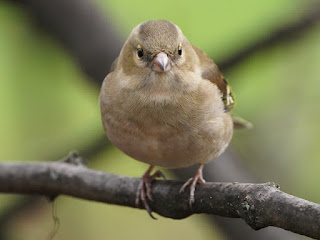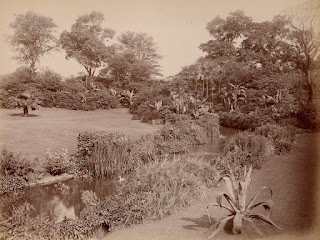The female Chaffinch from the Flower Walk, who usually doesn't venture far from home, came out with her mate and followed me up to the Round Pond, demanding pine nuts all the way.
The dominant Robin from the Flower Walk also came out. This Robin, which I photographed inside the walk, is one of several others along the path.
But when I got to the Round Pond there was no Little Owl to be seen, and she hadn't come into view when I went back later. I fear the squirrel which I saw in the hole yesterday has upset her domestic arrangements. But of course I will keep checking in case she returns.
A single Redwing could be seen in a tree near the Speke obelisk ...
... and a Blackbird hauled a worm out of a bit of bare ground.
Something in this patch of weeds and dead leaves below the Triangle car park was attracting a crowd of Feral Pigeons, but although I looked carefully at the place I couldn't see what.
A Magpie checked a clump of cut reeds in the Diana fountain reed bed. It pulled out stems, probably to see if there were any larvae clinging to them.
The mate of the nesting Grey Heron was waiting on a disused nest for its turn on the eggs, and decided to lie down comfortably to get out of the wind.
The old heron at the Henry Moore sculpture was standing next to the fence. It's been seen several times catching rats that carelessly look out of the undergrowth, but I don't know if this elderly and arthritic bird is still capable of it. It is still fishing, and people come and feed it to help keep it going.
The odd couple of a Herring Gull and a Lesser Black-Backed Gull, who have been together for several years, displayed and called on the edge of the Serpentine.
The pigeon eater had just caught a new victim when I arrived on his patch at the Dell restaurant.
The youngest Great Crested Grebe was fishing near the Serpentine outflow.
The gang of five teenage Mute Swans cruised up the edge. These privileged birds are going to have a rude shock in the spring when their parents start nesting again and throw them out.
A clump of dead irises in the Italian Garden, where on Thursday I photographed a Coot which had climbed to the top, had a pair of Mallards resting on it. They certainly flew to get there, as Mallards are useless at climbing.
The Dell, fenced off by railings, is the home of many kinds of birds. Here are a pair of Moorhens, which sometimes breed here; a Wood Pigeon; an Egyptian Goose, one of a pair that visit occasionally; some of the ubiquitous Carrion Crows; a young Grey Wagtail which was hatched in a nest under the waterfall; and a Grey Heron (the last two were filmed earlier).
The layout of the Dell as a carefully staged ideal landscape was the idea of Lord Redesdale (grandfather of the famous Mitford girls) who became Secretary of the Office of Works in 1874. The waterfall at the outflow of the Serpentine already existed, but he replanned the stream below to make it more picturesque and replaced the original scrubby undergrowth with lawns and subtropical plants. Here is a picture of the Dell around 1890, taken by an unknown photographer.
Today these plants have been largely replaced but there are still New Zealand tree ferns and other exotics at the top of the slope, and a Wollemi pine on the lower lawn -- which Redesdale could not have envisaged as this ancient tree, thought to be no more than a fossil, was only discovered growing in Australia in 1994. In the 20th century the waterfall was made a more prominent feature by adding an extra fall at the top, fed by an electric pump.
Here is a picture of the present view, taken by Virginia in the summer of 2018.
A squirrel sharpened its teeth on a bit of wood.
Rodents' teeth grow continuously and have to be ground down to keep them from getting too long. This sharpens them, as the enamel on the front of the tooth is harder than on the back so they wear to a chisel edge. Some of the aluminium signs on trees also show signs of having been gnawed by squirrels.
The sawn-off black poplar tree at Peter Pan has this handsome bracket fungus on it. At first I thought it was a clump of Oyster Mushrooms, which appear in different colours, but the scalloped edge shows that they are something else which I can't identify.
A very happy New Year to all readers, and may it be an improvement on the dismal showing of 2023.






%20killing%20pigeon%202023%203a.jpg)




%201a.jpg)


Hi Ralph, SUPERB blog today, an awful lot of information, especially the two pics of the dell.not really changed THAT much.....happy new year to all fellow bird lovers.regards,Stephen..
ReplyDeleteThank you, and a very happy New Year to you.
DeleteHave the odd gull couple, who I think should be called Simon & Garfunkel, ever been seen with progeny? And a happy New Year to you and other readers. Jim
ReplyDeleteNo, they haven't. But some of the Lesser Black-Backs here seem quite light grey even by the standards of the British intermedius variety, and it's possible we may have some hybrids. The two species can have fertile offspring together, so any degree of mixing is possible. Happy New Year.
ReplyDeleteHappy New Year to Ralph and to all the merry community that gathers daily around his blog! Here is to another year of lovely pictures and entertaining commentary from Ralph. The best is yet to come!
ReplyDeleteThank you, and a very happy New Year to you and yours.
DeleteHappy New Year to you and everyone who follows this blog :)
ReplyDeleteAnd to you. Good riddance to 2023.
DeleteHappy New Year to everyone!
ReplyDeleteTheodore
And happy New Year to you.
DeleteInteresting about the Dell. And a rare shot of the pigeon killer (almost) in flagrante delicto. Didn't know about hybrid gulls either - your blog is quite an education for me! Thank you
ReplyDeleteHerring Gulls, Lesser Black-Backs and Yellow-Legged Gulls are very closely related, and there have been suggestions that they should be lumped together as subspecies of one Larus species, even including the Common Gull as a smaller morph. At least that makes a change from the usual tendency of taxonomists to split everything into smaller and smaller bits.
DeleteBut that would take half the fun out of birding...
DeleteIf that's your idea of fun. I enjoy the unclassifiable.
Delete